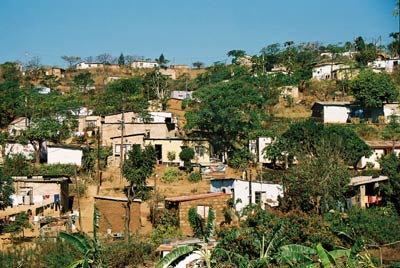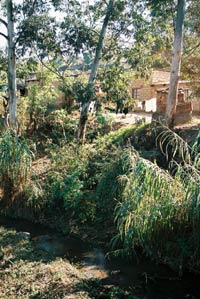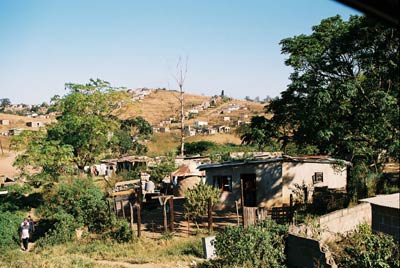Tiempo Climate Cyberlibrary
Ecosystems and Adaptation
- Tiempo archive
- Complete issues
- Selected articles
- Cartoons
- Climate treaty
- Latest news
- Secretariat
- National reports
- IPCC
About the Cyberlibrary
The Tiempo Climate Cyberlibrary was developed by Mick Kelly and Sarah Granich on behalf of the Stockholm Environment Institute and the International Institute for Environment and Development, with sponsorship from the Swedish International Development Cooperation Agency.
While every effort is made to ensure that information on this site, and on other sites that are referenced here, is accurate, no liability for loss or damage resulting from use of this information can be accepted.
 |
James Waters argues the importance of ecosystems and ecosystem services for poor urban communities likely to be affected by climate change. |
| Ecosystem services, such as protection from natural hazards and disease, play an important role in the lives of the urban poor. The debate on ecosystem-based adaptation needs to shift from an "ecosystems" to an "ecosystem services" approach, acknowledging the importance of ecosystems – even if they are degraded – for urban adaptation. | |
| The author is a PhD researcher at the University of East Anglia, United Kingdom, working on urban resilience and ecosystem services. | |
Over half of the world's population now lives in urban settlements. Severe climatic impacts are predicted for these areas and the need to address the threat of climatic impacts and find solutions is paramount. There has, however, been relatively little consideration of climate impacts on urban dwellers to date. Work on how communities may adapt to climate impacts has tended to focus on societal and engineering solutions. Meanwhile, in rural areas, "ecosystem-based adaptation" is a topical issue, both amongst practitioners and at the international climate negotiations. This approach refers to a range of strategies where communities work with ecosystems such that both ecosystems and society can adapt to climate change.
Here, we ask the question of why ecosystems are being ignored in poor urban areas, and whether they have a role in adapting to climate change here. In addition to examining what ecosystem-based adaptation means in practice and in policy contexts, observations from two townships on the outskirts of Durban, South Africa, highlight the ways in which ecosystems are of great use to poor urban communities.
Are ecosystem services important for the urban poor?
The work of the Millennium Ecosystem Assessment, amongst other studies, has shown that human societies are dependent on many aspects of ecosystems for their wellbeing. These aspects, whether used actively or passively, have been called "ecosystem services". In poor rural areas, it is obvious that the provision of services, such as food via agriculture or wood from forests, is important in people's livelihoods. How relevant are they then in urban areas?
It is important to note that many settlements in "urban" areas do not conform to western models of cities or traditional urban settlements. In sub-Saharan Africa, for example, 72 per cent of the urban population live in slums or informal settlements. At 78 per cent, this figure is even higher for the Least Developed Countries. These settlements are often found on the edge of burgeoning cities. They are not purely urban, nor are they rural, but rather contain a mix of the two. Such areas are described here as "peri-urban".
| A tale of two townships |
|---|
|
Amaoti and Ntshongweni are both townships on the outskirts of Durban, South Africa. Amaoti consists of a mixture of informal settlements and more formal housing. Serious crime is high, most of the community are on benefits and many people have HIV/AIDS. Threats include the risk of infectious disease (although not presently an issue), exacerbated by poor sanitation in some areas, dwellings located very close together and pressure on drainage systems. Ntshongweni on the other hand is much more rural, with lower crime rates and more social cohesion. The community is changing, however, and is becoming increasingly urbanized. These two communities are unique and different. With little land available in Amaoti, people are heavily reliant on bought food, and heavy rain damages buildings (often in the floodplain) and causes loss of life. Ntshongweni is unusual in that the community has much land. This, however, brings dependence on locally-grown crops and the risk of damage from heavy rainfall. Many people are already changing the types or amounts of crops they grow. These two communities illustrate many of the challenges faced by poor settlements on the edge of African cities. |
While much of the environment is polluted and there is little open green space, ecosystems may still provide a range of benefits to local communities. These may be direct, such as food production on small patches of land, or indirect, such as providing protection against natural hazards. For townships such as Amaoti or Ntshongweni, these benefits do not constitute the entire source of income or food for residents, but complement other sources such as food bought from local stores with income earned from jobs in town. In dense urban settlements like Amaoti, rivers are often polluted, there is little land for each household and soil stability is poor. Individuals cannot, therefore, depend solely on local natural resources for their entire income, food or wood supplies. Nevertheless, the contribution that these direct ecosystem services make is crucial as they diversify the sources of their goods - thereby spreading risk - and free up income for improving livelihoods. Ecosystem services can thus be of clear direct value to poor urban residents.
For the people of Amaoti, however, it is the more indirect services that arguably influence their lives most. In one informal settlement, residents choose to live in river floodplains and next to the river for various reasons, such as a preference for building shelter on land they do not have to rent. This puts them at high risk from flooding in times of storm surge or heavy rain. Such impacts are predicted to get worse with climate change. A vegetation buffer on the river's edge may help protect nearby houses and informal structures by absorbing some of the water's energy. In more rural locations, upland forests sometimes provide protection against heavy rainfall events. This "natural hazard protection" can also be vital in other habitats and locations, such as coastal areas and for protection against landslides.
 |
|
The township of Amaoti outside Durban, South Africa
© James Waters |
Ecosystems can improve the health of periurban populations in complex ways. Humans gain significant psychological benefits from having access to natural areas and green space. Ntshongweni residents, for example, often ascribe their relatively positive wellbeing to having "plenty of space" and it being a "nice environment".
A more tangible threat is the risk of infectious disease. Ecosystems can regulate the spread of infectious disease in a number of ways, depending on the disease and ecosystem. Anthropogenic drivers such as urban sprawl, agricultural land use or the distribution of surface waters affect infectious disease risk, for example, by providing breeding sites for air-borne disease vectors or a reservoir of host species such as snails. Scientists are still struggling to fully understand the complex dynamics of such ecosystem services. Recently, however, national doctors from around the world called on politicians to be aware of the imminent threat of climate change on health. The letter was published simultaneously in two prominent medical journals, the British Medical Journal and The Lancet, and stated that climate change will be "the biggest global health threat of the 21st century."
For residents of poor peri-urban areas, outbreaks of water-borne disease will be highly dependent on the state of water courses. Meanwhile, as forests act as potential reservoirs of disease, rapid urban sprawl into forested areas may result in the spread of vector-borne diseases such as dengue fever. The impacts of climate change on diseases such as malaria are still not entirely clear, but they should not be underestimated. As urbanization continues apace, ecosystem dynamics, and the benefits and problems that ecosystems provide for urban areas need considering in conjunction with climate change scenarios. For Amaoti, residents are largely unaware of the ecosystem services that are now in jeopardy, precisely at the time when they may increasingly be needed.
Analysis of a survey and detailed information from semi-structured interviews revealed that the most utilized ecosystem services in Amaoti and Ntshongweni were protection against natural hazards, crop production and water regulation. Services utilized will differ from place to place but what is fundamental here is that poor urban areas cannot escape the influence of ecosystems, however degraded they may be. Unfortunately, natural environments tend to be seriously degraded in areas where there is urban sprawl. This, however, provides opportunities to support novel ways to adapt to future climate impacts under which ecosystems should not be ignored.
The services most at risk from climate change are often the least valued and understood
The ecosystem services of most concern to residents in the context of climate change will be those that are most utilized or most severely affected. Assessing the effects of climate change is not easy, but it was estimated using local climate predictions and expert knowledge of ecosystem functioning.
 |
|
Settlements can erode natural buffer zones
© James Waters |
For Amaoti and Ntshongweni, a combination of climatic factors and future population pressure meant that the communities were particularly vulnerable to reduced protection from natural hazards, reduced protection against (and even a disservice by spreading) infectious disease, and potential crop failures. Worryingly, these services are the least understood and the least valued at the local level. The communities put little or no value on ecosystem protection against natural hazards, partly due to the long-term nature of the threat and partly because of the difficulty in managing such habitats collectively for communal gain. This acted only to further degrade this service. Understanding regarding the threat of infectious diseases was lacking in these settlements. This is unsurprising given the current state of knowledge amongst practitioners and scientists, and the novelty of potential climate impacts. It is evident that in these peri-urban and urban townships climate change and ecosystems are crucially interlinked.
Ecosystem-based approaches
Given the dependence of poor urban dwellers on certain ecosystem services, it makes sense to focus some adaptation activities around these systems. This would complement many existing development goals, such as providing piped water to every household, but could also lead to more resilient integrated approaches to development. Current literature, however, suggests that ecosystem-based adaptation is only relevant in rural settings or pristine habitats.
Internationally, the term ecosystem-based adaptation appeared in various United Nations Framework Convention on Climate Change negotiating sessions in June and August during 2009. Despite this attention, it was evident that there was confusion regarding what the term actually meant and whether it should be included in the negotiating text. Examples given by proponents of ecosystem-based adaptation included habitats such as coastal mangroves and wetlands. Further discussion at a technical workshop in October 2009 highlighted specific ecosystems such as mountain, freshwater and dryland systems, rather than focusing on ecosystem services more widely. Once more, clarification of terminology was noted as a priority. The Ad Hoc Technical Expert Group on Biodiversity and Climate Change discussed similar issues at length, but focused on "rural or poor communities" rather than urban communities. Encouragingly, the restoration and rehabilitation of degraded systems was mentioned along with maintenance of critical processes and functions.
The topic continues to gain attention in these international meetings and processes and in academic circles, but at this stage it is too early to expect national strategies to deal with ecosystem-based adaptation as is proposed here. Urban areas are also frequently poorly represented. For example, very few National Adaptation Programmes of Actions have identified urban-specific climate change impacts. Several non-government organizations are pushing for the development of ecosystem-based adaptation strategies and for ideas and guidance on this. Yet again we find the same pattern: across all programmes and briefing papers found on the topic, case studies and examples are based on extensive semi-natural ecosystems such as forests, grasslands, coasts and coral reefs. Urban or peri-urban ecosystems simply do not feature. One 2008 study of peri-urban areas highlighted the need to value ecosystem services in this context, but it seems this has not filtered up to wider climate change adaptation debates. The only exception where urban areas are included in ecosystem-based adaptation discussions concerns water provision through protection of the surrounding watershed.
 |
|
A peri-urban township in South Africa: a mix of
urban and rural
© James Waters |
Considering ecosystem services in debates about the role of ecosystem-based adaptation brings one to a different conclusion regarding the breadth and importance of approaches for climate change adaptation that use ecosystems. An ecosystem service lens incorporates all aspects of ecosystems that can be utilized, however degraded. Moreover, this approach is one that acknowledges the direct and indirect benefits for both urban and rural residents alike.
Ecosystem-based adaptation in an urban world?
The concept of ecosystem-based adaptation holds exciting promise for meeting the multiple goals of environmental protection, development and adaptation to climate change. Current thinking implies that the approach might only be applied to extensive ecosystems that are invariably in rural areas. The evidence from Amaoti, however, shows that many urban settlements, including poor peri-urban areas, use ecosystem services in a variety of ways that underpin their livelihoods. Whilst further ecosystem degradation may not destroy community livelihoods, it will certainly undermine community resilience.
Whilst ecosystem-based adaptation may not feature significantly in the portfolio of adaptation options in all circumstances, by examining the broader suite of ecosystem services that humans make use of, including indirect ones such as protection from natural hazards or disease regulation, the case for an approach that includes ecosystems becomes much stronger. Such an approach also includes urban areas and ecosystems that are degraded. It is, therefore, important to shift from an ecosystems perspective to an ecosystem service perspective, and to at least acknowledge that ecosystems exist in urban environments too. Whether living next to an extensive mangrove system or a degraded city river, people will be influenced by the ecosystems that surround them. In order not to detract from the momentum that the ecosystem-based adaptation approach concept has gained, this shift should not detract from the current good work that is occurring in this field. Rather, it encourages a widening of application, through a broader examination of the range of benefits that citizens derive from the natural world on which we all depend.
There are serious challenges to building on the ecosystem-based approach. These include understanding how degraded ecosystems function and provide adaptation benefits, how to value ecosystems in urban areas and halt their degradation and how to integrate this approach with other adaptation options. Urban planners and decision-makers have tended to ignore ecosystem goods and services for too long. Meanwhile, there is also the current risk that ecosystem-based adaptation will become the privilege of extensive, healthy ecosystems and surrounding rural populations. It is hoped that both will be reconciled, facilitating resilient development for rural and urban populations alike, as well as all those in between.
Further information
James Waters, Tyndall Centre for Climate Change Research, School of Environmental Sciences, University of East Anglia, Norwich NR4 7TJ, United Kingdom. Email: james.waters@uea.ac.uk. Web: www.tyndall.ac.uk.
On the Web
The Nature & Poverty Knowledge and Learning Network provides a platform for practitioners working on ecosystem management and poverty alleviation. A call has recently been issued for sharing experiences and case studies relating to ecosystem-based adaptation. A World Bank publication, Convenient Solutions for an Inconvenient Truth: Ecosystem-based Approaches to Climate Change, is available (2.5MB download). Finally, the Tiempo Climate Cyberlibrary carries a listing of selected websites concerned with ecosystems and climate.
Bright Ideas

General Electric plans to cut solar installation costs by half

Project 90 by 2030 supports South African school children and managers reduce their carbon footprint through its Club programme

Bath & North East Somerset Council in the United Kingdom has installed smart LED carriageway lighting that automatically adjusts to light and traffic levels

The United States National Oceanic and Atmospheric Administration and the American Public Gardens Association are mounting an educational exhibit at Longwood Gardens showing the link between temperature and planting zones

The energy-efficient Crowne Plaza Copenhagen Towers hotel is powered by renewable and sustainable sources, including integrated solar photovoltaics and guest-powered bicycles
El Hierro, one of the Canary Islands, plans to generate 80 per cent of its energy from renewable sources

The green roof on the Remarkables Primary School in New Zealand reduces stormwater runoff, provides insulation and doubles as an outdoor classroom

The Weather Info for All project aims to roll out up to five thousand automatic weather observation stations throughout Africa

SolSource turns its own waste heat into electricity or stores it in thermal fabrics, harnessing the sun's energy for cooking and electricity for low-income families

The Wave House uses vegetation for its architectural and environmental qualities, and especially in terms of thermal insulation

The Mbale compost-processing plant in Uganda produces cheaper fertilizer and reduces greenhouse gas emissions

At Casa Grande, Frito-Lay has reduced energy consumption by nearly a fifth since 2006 by, amongst other things, installing a heat recovery system to preheat cooking oil
Updated: May 15th 2015